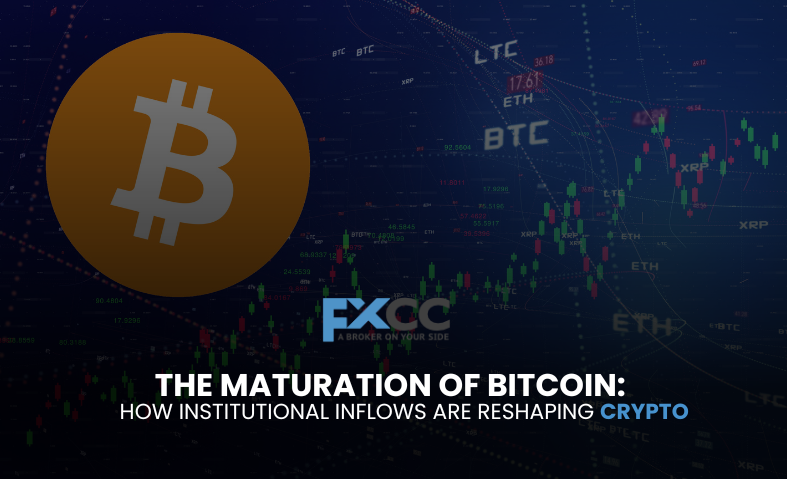For years, Bitcoin was often viewed as a rogue asset, a speculative gamble largely confined to tech enthusiasts and early adopters. Fast-forward to mid-2025, and the narrative has dramatically shifted. Bitcoin, despite its inherent volatility, is undeniably maturing into a recognized asset class, largely propelled by the steady and significant inflow of institutional capital. This shift isn’t just a trend; it’s a fundamental reshaping of the cryptocurrency landscape, ushering in an era of greater legitimacy, infrastructure, and perhaps, a new form of stability.

The Institutional Onslaught: ETFs Leading the Charge
The most visible testament to Bitcoin’s maturation is the approval and success of spot Bitcoin Exchange-Traded Funds (ETFs) in major financial markets like the United States. These regulated investment vehicles have acted as a crucial bridge, allowing traditional financial institutions – from pension funds to wealth management firms – to gain exposure to Bitcoin without the complexities of direct ownership.
Previously, concerns around custody, security, and regulatory uncertainty were major deterrents for institutional players. Bitcoin ETFs have largely alleviated these issues, offering a familiar, regulated product that fits within existing investment frameworks. As a result, we’ve seen substantial net inflows into these ETFs, with major players like BlackRock and Fidelity accumulating significant Bitcoin holdings. This isn’t just retail enthusiasm; it’s a clear signal that the financial old guard is increasingly comfortable with Bitcoin as a legitimate investment.
Reshaping Market Dynamics: Beyond Retail Dominance
The influx of institutional capital has profound implications for Bitcoin’s market dynamics. Historically, Bitcoin’s price movements were heavily influenced by retail sentiment, often leading to rapid, volatile swings driven by speculation and social media trends. While retail investors certainly still play a role, institutional participation is introducing a new layer of stability and sophistication.
Large institutional players often operate with long-term investment horizons, driven by fundamental analysis and portfolio diversification strategies rather than short-term gains. Their consistent buying pressure, even during market dips, helps to absorb selling pressure and establish higher price floors. We’re seeing evidence of this as Bitcoin has pushed past previous all-time highs, holding strong above critical psychological levels like $120,000, even amidst significant whale sell-offs. The market’s ability to absorb such large transactions with relatively minor price fluctuations is a direct reflection of this growing institutional backing.
Furthermore, institutions are bringing a demand for more robust and reliable infrastructure. This includes regulated custody solutions, advanced trading platforms, and comprehensive data analytics, all of which contribute to a more professional and liquid market.
The Regulatory Catalyst: A Path to Clarity
A significant factor enabling institutional adoption has been the evolving regulatory landscape. Governments and financial bodies worldwide are increasingly recognizing the need for clear guidelines for digital assets. In the US, for example, the GENIUS Act (which aims to Guide and Establish National Innovation for U.S. stablecoins) was passed recently. This kind of legislative progress supports the idea that “same activity, same risk, same regulation” is becoming the norm, creating a more level playing field for crypto within the wider financial system. Stablecoins Act) in July 2025 has provided much-needed clarity for stablecoins, setting a precedent for broader crypto integration.
While regulatory uncertainty still exists in some areas, the general trend is towards establishing frameworks that promote innovation while safeguarding investors and ensuring market integrity. This regulatory clarity is paramount for institutions, as it reduces legal and compliance risks, making Bitcoin a more palatable asset for their clients and internal portfolios. The United States has seen legislative developments, such as the passage of the GENIUS Act, designed to foster innovation and provide guidance for U.S. stablecoins. This movement reflects a broader trend towards the principle of “same activity, same risk, same regulation,” which is helping to integrate crypto more seamlessly into the existing financial framework.
Bitcoin as “Digital Gold” and a Macro Hedge
Beyond pure speculation, institutions are increasingly viewing Bitcoin through the lens of “digital gold” – a hedge against inflation and a store of value in an uncertain global economy. With persistent inflationary concerns and mounting government debt globally, traditional safe-haven assets are being re-evaluated. Bitcoin’s fixed supply of 21 million coins, governed by an immutable algorithm, stands in stark contrast to the expanding money supply of fiat currencies.
This scarcity, combined with its global accessibility and decentralized nature, makes it an attractive alternative for institutions seeking to diversify their portfolios and protect against currency debasement. Many are allocating a small but growing percentage of their assets to Bitcoin, treating it as a strategic long-term investment rather than a short-term trade. This strategic positioning reinforces Bitcoin’s role as a legitimate asset, moving it from the fringes to a core component of diversified investment strategies.

The Road Ahead: Continued Evolution
The maturation of Bitcoin is an ongoing process. While institutional inflows have undeniably reshaped the crypto landscape, the journey is far from over. Challenges remain, including the need for even greater regulatory harmonization across different jurisdictions, continued improvements in security infrastructure to combat sophisticated hacks, and a deeper understanding of Bitcoin’s long-term correlation with traditional assets.
However, the trajectory is clear. Bitcoin, once an obscure digital experiment, is firmly establishing itself as a significant asset in the global financial system. The quiet accumulation by global banks, the success of regulated investment products, and the evolving regulatory environment all point to a future where Bitcoin is not just tolerated, but actively embraced by institutional finance, further cementing its place as a truly mature asset class.


